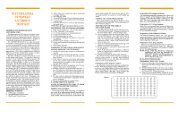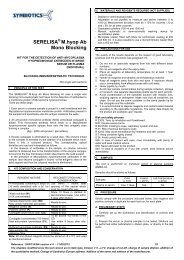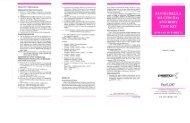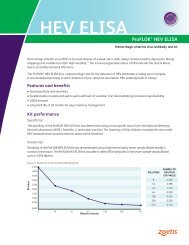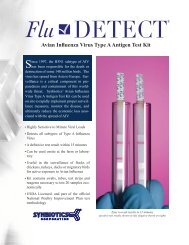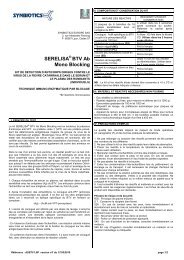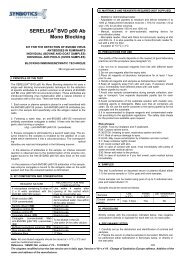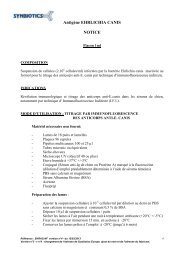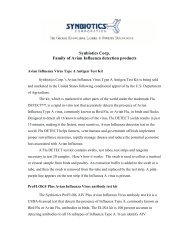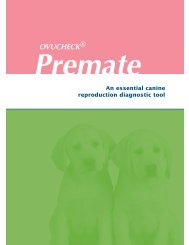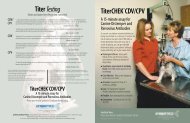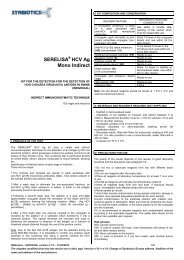WITNESS® FeLV-FIV SYNBIOTICS EUROPE
WITNESS® FeLV-FIV SYNBIOTICS EUROPE
WITNESS® FeLV-FIV SYNBIOTICS EUROPE
You also want an ePaper? Increase the reach of your titles
YUMPU automatically turns print PDFs into web optimized ePapers that Google loves.
WITNESS ® <strong>FeLV</strong>-<strong>FIV</strong><br />
Français page 1<br />
English page 5<br />
Deutsch Seite 9<br />
Nederlands bladzijde 13<br />
Español página 17<br />
Italiano pagina 21<br />
Português página 25<br />
<strong>SYNBIOTICS</strong> <strong>EUROPE</strong> - 2, rue Alexander Fleming - 69367 LYON Cedex 07- FRANCE<br />
Tél.: +33(0)4 72 76 11 11 - Fax.: +33(0)4 72 76 11 10<br />
SBio Version n° 3 du 18/08/10
WITNESS ® <strong>FeLV</strong>-<strong>FIV</strong><br />
GENERALITES<br />
Le virus de la leucémie féline (<strong>FeLV</strong>) est un rétrovirus du groupe mammalien type C, de répartition mondiale et particulièrement<br />
endémique dans les populations de chats vivant en collectivité ou ayant de nombreux contacts rapprochés.<br />
La transmission se fait essentiellement par contact, principalement par l’intermédiaire de la salive et des secrétions<br />
nasales, à l’occasion de morsures ou par léchage. Une transmission verticale est également possible. Les animaux<br />
virémiques persistants, porteurs chroniques de virus sont la principale source de virus.<br />
L’infection se caractérise par le développement d’une virémie pouvant être suivie d’une séroconversion avec élimination<br />
de l’agent pathogène. Le passage à un stade d’infection chronique s’accompagne généralement du développement<br />
de syndromes de type prolifératif (lymphosarcome ou leucémie) ou non prolifératif (anémie, immunosuppression)<br />
conduisant à terme à la mort de l’animal atteint.<br />
Le diagnostic de l’infection se fait généralement par la mise en évidence d’un antigène viral, la protéine de capside<br />
p27, présente en quantité importante chez les chats virémiques.<br />
Le virus de l’immunodéficience féline (<strong>FIV</strong>) est un lentivirus de répartition mondiale, dont l’identification remonte à<br />
1986. La prévalence de l’infection varie de moins de 1% à plus de 20% selon la population de chats (sexe, mode de<br />
vie, âge), l’état de santé et la région géographique considérés.<br />
La maladie se transmet essentiellement par morsure et est caractérisée, dans un premier temps, par un épisode fébrile<br />
transitoire, suivi d’une longue période apparemment normale. C’est ensuite, que sont décrites des affections, telles<br />
que stomatites, gastro-enterites, lymphadenopathies, troubles neurologiques, les chats atteints succombant finalement<br />
au développement d’infections opportunistes ou de tumeurs.<br />
Cette infection par le <strong>FIV</strong> s’accompagne de l’apparition rapide d’anticorps, dont ceux dirigés contre la glycoprotéine<br />
transmembranaire, gp40, qui sont considérés parmi les plus précoces. Leur présence dans le sang du patient permet<br />
de témoigner que celui-ci a été exposé au virus, même s’il n’existe pas de signes cliniques particulièrement évocateurs.<br />
INDICATIONS DU TEST<br />
Le test WITNESS ® <strong>FeLV</strong>-<strong>FIV</strong> sera indiqué en cas de suspicion d’infection par un rétrovirus félin (<strong>FeLV</strong> ou/et <strong>FIV</strong>) sur<br />
la base d’une symptomatologie évocatrice et/ou d’un possible historique d’infection, notamment en préalable, à la<br />
mise en place d’une éventuelle vaccination <strong>FeLV</strong>.<br />
PRINCIPE DU TEST<br />
Le test WITNESS ®<br />
<strong>FeLV</strong>-<strong>FIV</strong> est un test de réalisation simple fondé sur une technique d’Immuno Migration Rapide<br />
(Rapid Immunomigration, RIM).<br />
La mise en évidence du virus <strong>FeLV</strong> fait appel à des anticorps dirigés contre la protéine de capside p27.<br />
La détection du <strong>FIV</strong> utilise un peptide reproduisant un épitope de la région transmembranaire gp40 du virus et est<br />
basée sur la présence d’anticorps circulant contre cette protéine.<br />
Dans les deux cas, des particules d’or sensibilisées, au contact des échantillons, forment un complexe avec soit la<br />
p27 (<strong>FeLV</strong>) soit les anticorps (<strong>FIV</strong>).<br />
1
Les complexes ainsi formés migrent sur les membranes avant d’être capturés au niveau d’une zone réactive à la hauteur<br />
de laquelle leur concentration provoque la formation d’une bande de couleur rose, clairement visible.<br />
Une bande de contrôle située à l’extrémité de chaque membrane permet de s’assurer que le test ait été réalisé correctement.<br />
ECHANTILLONS<br />
• Le test peut être réalisé sur du sang total avec anticoagulant (EDTA ou héparine), du sérum ou du plasma, prélevé<br />
de façon stérile.<br />
• L’hémolyse n’interfère pas significativement avec le test, bien qu’un échantillon fortement hémolysé puisse être à<br />
l’origine d’un bruit de fond (hémoglobine) pouvant gêner la lecture en cas de réaction faiblement positive.<br />
Conservation des échantillons<br />
Les échantillons peuvent être conservés à température ambiante, mais pas plus de 4 heures suivant le prélèvement.<br />
Si l’analyse est repoussée (jusqu’à 4 jours), l’échantillon devra être conservé réfrigéré entre +2 et 8°C. Pour une<br />
conservation prolongée, il sera conseillé de congeler l’échantillon à -20°C (sérum, plasma).<br />
CONTENU DU KIT<br />
A. 10 sachets, contenant chacun une plaquette test et un sachet déshydratant.<br />
B. Un flacon compte-gouttes de solution tampon (de 2,8 ml).<br />
C. Une notice d’emploi.<br />
D. 10 pipettes.<br />
PRECAUTIONS<br />
1. Ne pas utiliser de réactifs après la date de péremption.<br />
2. Conserver le kit entre +2°C et 25°C. Ne pas congeler.<br />
3. Utiliser le test immédiatement après ouverture du sachet (dans les 10 minutes après ouverture du sachet).<br />
4. Placer la plaquette sur une surface plane et horizontale pour permettre une migration correcte de l’échantillon.<br />
5. Eviter de toucher ou d’endommager les membranes réactives (puits échantillon (1) et fenêtre de lecture (2), (3)).<br />
6. Utiliser une pipette différente pour chaque échantillon.<br />
7. Tenir la pipette et le flacon de solution tampon de façon verticale lors de la distribution des échantillons et du<br />
réactif.<br />
8. Manipuler les réactifs et les échantillons comme des produits à risque.<br />
9. Pour usage vétérinaire uniquement.<br />
REALIZAÇÃO DO TESTE - RESULTADOS<br />
Importante : Deixe cair as gotas da amostra e da solução tampão sobre a membrana da cúpula da amostra(janela 1).<br />
Não colocar a ponta da pipeta nem as gotas da amostra e da solução tampão directamente em contacto com a<br />
membrana.<br />
1. Distribuição da amostra<br />
• Abrir uma carteira, retirar da mesma a pipeta e a<br />
placa-teste e colocá-la sobre uma superfície plana<br />
• Colher a amostra por meio da pipeta fornecida e,<br />
mantendo-a na vertical colocar uma gota em cada<br />
cúpula da amostra (1).<br />
3. Leitura do teste<br />
Observar, ao fim de 10 minutos, a presença (ou não)<br />
de faixas cor de rosa nas janelas (2) e (3).<br />
Observações :<br />
• É possível concluir a leitura do teste antes de 10 minutos<br />
se duas faixas cor de rosa (correspondentes respectivamente<br />
à faixa-teste e à faixa-testemunha em<br />
(3)) aparecerem nitidamente.<br />
• Pelo contrário, o simples aparecimento de uma faixa<br />
ao nível do ponto de referência (3) não permite<br />
concluir o teste enquanto não passarem os 10 minutos<br />
necessários ao seu completo desenvolvimento.<br />
Com efeito, esta faixa de controlo pode aparecer mais<br />
precocemente do que a faixa-resultado em (2), particularmente<br />
no caso de amostras fracamente positivas.<br />
2. Distribuição da solução tampão<br />
• Depois de ter a certeza de que a amostra penetrou<br />
bem na membrane.<br />
• Tirar a rolha do frasco de solução tampão e, segurando-o<br />
na vertical, colocar três gotas da solução<br />
nas cúpulas da amostra (1).<br />
• Deixar, depois, a placa-teste bem na horizontal<br />
durante todo o tempo da migração do complexo<br />
amostra/reagente sobre a banda reactiva.<br />
4. RESULTADOS<br />
1. Validação<br />
O teste é válido se uma faixa estiver presente na janela de<br />
leitura ao nível do ponto de referência correspondente (3).<br />
2. Interpretação<br />
• Ausência de uma faixa cor de rosa ao nível do ponto de<br />
referência (2) (após um período de desenvolvimento de 5<br />
minutos) : negativo em antigénio <strong>FeLV</strong> e/ou em anticorpos<br />
<strong>FIV</strong>.<br />
• Presença de uma faixa cor de rosa ao nível do ponto de<br />
referência (2) : positivo em antigénio <strong>FeLV</strong> e/ou em anticorpos<br />
<strong>FIV</strong>.<br />
Atenção :<br />
• A ausência de uma faixa cor de rosa ao nível do ponto de<br />
referência (3) torna o teste não válido.<br />
• A interpretação de qualquer teste de diagnóstico deve<br />
fazer-se em função do contexto clínico e epidemiológico<br />
do animal testado.<br />
2 27
Os complexos formados migrarão ao longo das placas. Os complexos são então capturados na banda reactiva sensibilizada,<br />
onde a sua acumulação provoca a formação de uma banda cor de rosa, claramente visível.<br />
Bandas de controlo localizadas nas ultimas das janelas de leitura (3) asseguram que o feste foi realizado correctamente.<br />
AMOSTRAS<br />
• O teste pode ser efectuado em sangue total não coagulado (EDTA ou heparina), em soro ou em plasma, colhidos<br />
de maneira estéril.<br />
• A hemólise não interfere significativamente com o teste, se bem que, uma amostra fortemente hemolizada possa<br />
estar na origem de uma interferência (hemoglobina) que possa perturbar a leitura em caso de reacção fracamente<br />
positiva.<br />
Conservação das amostras<br />
As amostras de sangue total com anticoagulante devem ser testadas logo após a colheita e nunca depois de 4 horas<br />
se mantidas à temperatura ambiente.<br />
Se o teste fôr feito mais tarde, as amostras devem ser conservadas no frigorífico (+2°C a 8°C) até 4 dias.<br />
Para conservação mais prolongada, as amostras (apenas soro ou plasma) devem ser mantidas congeladas a -20°C.<br />
CONTEÚDO DO KIT<br />
A. 10 carteiras, contendo cada uma delas uma placa-teste e uma saqueta desidratante.<br />
B. Um frasco conta-gotas de solução tampão (de 2,8 ml).<br />
C. Um folheto com o modo de emprego.<br />
D. 10 pipetas.<br />
PRECAUÇÕES<br />
1. Não utilizar reagentes para além da data de validade.<br />
2. Conservar o kit entre +2°C e 25°C. Não congelar.<br />
3. Utilizar o teste imediatamente após a abertura (nos 10 minutos após a abertura da carteira).<br />
4. Colocar a placa sobre uma superfície plana e horizontal para permitir uma migração correcta da amostra.<br />
5. Evitar tocar ou deteriorar as membranas reactivas (cúpula-amostra (1) e janela de leitura (2), (3)).<br />
6. Utilizar uma pipeta diferente para cada amostra.<br />
7. Manter a pipeta e o frasco de solução tampão em posição vertical aquando da distribuição das amostras e do<br />
reagente.<br />
8. Manipule os reagentes e amostras como material com risco biológico.<br />
9. Apenas para uso veterinário.<br />
26<br />
REALISATION DU TEST ET RESULTATS<br />
Important : Laisser tomber les gouttes d’échantillon et de solution tampon sur la membrane dans le puits échantillon,<br />
fenêtre (1). Ne pas mettre l’extrémité de la pipette ou celle du compte-gouttes, ni les gouttes d’échantillon ou de<br />
solution tampon, directement en contact avec la membrane.<br />
1. Répartition de l’échantillon<br />
• Ouvrir un sachet, en retirer la plaquette test et placer<br />
celle-ci sur une surface plane.<br />
• Prélever l’échantillon grâce à la pipette fournie et,<br />
tout en tenant celle-ci bien verticalement, en répartir<br />
une goutte dans chaque puits échantillon (1).<br />
3. Lecture du test<br />
Observer au bout de 10 minutes, la présence ou non de<br />
bandes de couleur rose dans chacune des fenêtres (2)<br />
et (3).<br />
Remarques :<br />
• il est possible de conclure la lecture du test avant 10<br />
minutes si deux bandes de couleur rose (correspondant<br />
respectivement à la bande test et à la bande<br />
témoin en (3)) sont nettement apparues ;<br />
• par contre, la seule apparition d’une bande au niveau<br />
du repère (3) ne permet pas de conclure le test tant<br />
que les 10 minutes nécessaires à son développement<br />
complet ne se sont pas écoulées. En effet, cette bande<br />
de contrôle peut apparaître plus précocement que la<br />
bande résultat en (2), notamment dans le cas d’échantillons<br />
faiblement positifs.<br />
2. Répartition de la solution tampon<br />
• S’assurer que l’échantillon ait bien pénétré dans la<br />
membrane.<br />
• Oter le bouchon du flacon de solution tampon et,<br />
tout en tenant celui-ci bien verticalement, répartir<br />
trois gouttes de la solution dans chaque puits échantillon<br />
(1).<br />
• Laisser ensuite la plaquette test bien à plat durant<br />
tout le temps de la migration du complexe échantillon<br />
/ réactif sur la bandelette.<br />
RESULTATS<br />
1. Validation<br />
Le test est validé si une bande est présente dans chacune<br />
des fenêtres de lecture au niveau du repère (3).<br />
2. Interprétation<br />
• Absence d’une bande de couleur rose au niveau du repère<br />
2 : négatif en antigène <strong>FeLV</strong> et/ou en anticorps anti-<strong>FIV</strong>.<br />
• Présence d’une bande de couleur rose au niveau du repère<br />
2 : positif en antigène <strong>FeLV</strong> et/ou en anticorps anti-<strong>FIV</strong>.<br />
Attention :<br />
• L’absence d’une bande de couleur rose au niveau du repère<br />
(3) rend le test invalide.<br />
• L’interprétation de tout test de diagnostic doit se faire en<br />
fonction du contexte clinique et épidémiologique de l’animal<br />
testé.<br />
3
4<br />
WITNESS ® <strong>FeLV</strong>-<strong>FIV</strong><br />
GENERALIDADES<br />
O vírus da leucose felina (<strong>FeLV</strong>) é um retrovírus do tipo C dos mamíferos de difusão mundial e particularmente endémico<br />
nas populações de gatos vivendo em colectividade ou tendo numerosos e frequentes contactos.<br />
A transmissão faz-se essencialmente por contacto, principalmente por meio da saliva e das secreções nasais, ao<br />
morder ou lamber. Uma transmissão vertical é também possível. A principal fonte de vírus é representada pelos animais<br />
virémicos persistentes, portadores crónicos de vírus.<br />
A infecção caracteriza-se pelo desenvolvimento de uma virémia que pode ser seguida de uma seroconversão com<br />
eliminação do agente patogénico. A passagem a um estado de infecção crónica acompanha-se geralmente do desenvolvimento<br />
de síndromes de tipo proliferativo (linfosarcoma ou leucemia) ou não proliferativo (anemia, imunossupressão)<br />
levando, com o tempo, à morte do animal afectado.<br />
O diagnóstico da infecção faz-se geralmente pela evidenciação de um antigénio viral, a proteína da cápside p27, presente<br />
em grande quantidade nos gatos virémicos.<br />
O vírus da imunodeficiência felina (<strong>FIV</strong>) é um lentivírus difundido mundialmente, cuja identificação remonta a 1986<br />
(PEDERSEN). A prevalência da infecção varia de menos de 1% a mais de 20% segundo a população de gatos (sexo,<br />
modo de vida, ...), o estado de saúde e a região geográfica considerados.<br />
A doença transmite-se essencialmente por mordedura e caracteriza-se, num primeiro período, por um episódio febril<br />
transitório, seguido de um longo período aparentemente normal. Posteriormente registam-se afecções, tais como<br />
estomatites, gastroenterites, linfadenopatias..., acabando os gatos afectados por sucumbir pelo desenvolvimento de<br />
infecções oportunistas ou de tumores.<br />
Esta infecção pelo <strong>FIV</strong> é acompanhada do aparecimento rápido de anticorpos, entre os quais se contam os dirigidos<br />
à glicoproteína transmembranária, gp40, que são considerados serem dos mais precoces. A sua presença no sangue<br />
do paciente permite constatar que este foi exposto ao vírus, mesmo que não existam sinais clínicos particularmente<br />
reveladores.<br />
INDICAÇÕES DO TESTE<br />
O teste WITNESS ® <strong>FeLV</strong>-<strong>FIV</strong> está indicado em casos de suspeita de infecção por retrovírus felinos com base numa<br />
sintomatologia compatível e/ou numa possivel história de infecção.<br />
O teste é também particularmente recomendado antes da vacinaçáo <strong>FeLV</strong> principalmente em gatos que pertencem a<br />
populações de risco.<br />
PRINCÍPIO DO TESTE<br />
O teste WITNESS ®<br />
<strong>FeLV</strong>-<strong>FIV</strong> é um teste simples, baseado na tecnologia da imunomigração rápida (Rapid Immuno<br />
Migration, RIM).<br />
O antigénio da leucose felina é detectado usando anticorpos direccionados contra a proteina da cápside p27, circulante.<br />
A detecção do <strong>FIV</strong> é baseada na presença de anticorpos contra a região transmembranária de vírus, usando um peptido<br />
sintético da proteína gp40.<br />
Em ambos os casos, particulas de ouro coloidal vão formar um complexo com o antigénio p27 (<strong>FeLV</strong>) ou com anticorpos<br />
(<strong>FIV</strong>) presentes na amostra.<br />
25
24<br />
WITNESS ® <strong>FeLV</strong>-<strong>FIV</strong><br />
GENERAL INFORMATION<br />
Feline Leukaemia Virus (<strong>FeLV</strong>) is a contagious retrovirus from the Mammalian Type-C group, which is endemic in many<br />
areas of the world. The prevalence of <strong>FeLV</strong> is particularly high among dense populations.<br />
Transmission occurs essentially by contact, mainly through saliva or nasal secretions and by biting or licking.<br />
Clinically healthy persistantly viraemic cats are known as a major source of the virus.<br />
Infection is characterised by the development of a viraemia which can be followed by seroconversion with elimination<br />
of the pathogen. Infected cats may also present a chronic, persistent viraemia which will lead to the development<br />
of both proliferative syndromes like lymphosarcoma or leukaemia and non-proliferative syndromes such as<br />
anaemia or immunosuppression, followed by death at short or middle term.<br />
Diagnosis of <strong>FeLV</strong> infection is generally performed by the detection of a viral antigen from the core protein, p27, which<br />
is produced in high quantities in viraemic cats.<br />
Feline Immunodeficiency Virus (<strong>FIV</strong>) is a lentivirus of worldwide distribution, first isolated in 1986 from several cats<br />
exhibiting signs of immunodeficiency. Prevalence rates vary from less than 1% to more than 20%, depending on the<br />
cat population (sex, age, behaviour), health status, and geographical area.<br />
<strong>FIV</strong> is most commonly transmitted by biting. The infection is firstly expressed by a transient primary illness lasting<br />
several weeks, followed by a long period of apparent normal health which precedes a terminal immunodeficiency<br />
phase characterised by ailments such as generalised lymphadenopathy, stomatitis, gastro-enteritis, anaemia and neurological<br />
disorders. Affected cats will finally die from the development of a variety of secondary opportunistic infections<br />
or tumours.<br />
Infection by <strong>FIV</strong> is generally accompanied by a rapid rise of antibody levels, particularly those directed against the<br />
transmembrane protein of the virus, gp40. The presence of anti-gp40 antibodies indicates that the cat has been exposed<br />
to the virus, even in the case of complete absence of symptoms.<br />
TEST INDICATION<br />
WITNESS ® <strong>FeLV</strong>-<strong>FIV</strong> test is indicated for use when history and/or clinical signs may suggest an infection by feline<br />
retroviruses. It will also be particularly recommended prior to an <strong>FeLV</strong> vaccination, especially in cats belonging to an<br />
at risk population.<br />
TEST PRINCIPLE<br />
The WITNESS ® <strong>FeLV</strong>-<strong>FIV</strong> is a simple test based on Rapid Immuno Migration (RIM) technology.<br />
<strong>FeLV</strong> antigen is detected using antibodies directed against the circulating p27 capside protein.<br />
The detection of <strong>FIV</strong> is based on the presence of antibodies against the transmembrane region of the virus, using a<br />
synthetic peptide from the gp40 protein.<br />
In both cases, sensitised colloidal gold particles will form a complex with either the p27 antigen (<strong>FeLV</strong>) or antibodies<br />
(<strong>FIV</strong>) present in the sample.<br />
5
The formed complexes migrate along the strips. The complexes are then captured on a sensitised reaction line where<br />
their accumulation causes the formation of a clearly visible pink band.<br />
Control bands located at the end of the reading windows (3) ensure that the test was performed correctly.<br />
SPECIMEN INFORMATION<br />
• The test can be performed on unclotted whole blood anticoagulated with EDTA or heparin, serum or plasma.<br />
• Samples should always be collected with a sterile needle and syringe.<br />
• Haemolysis does not significantly interfere with the test, but strongly haemolysed samples may partly obscure a<br />
weak positive band.<br />
Storage<br />
Anticoagulated whole blood samples should preferably be tested immediately after collection but not longer than 4<br />
hours after collection, if stored at room temperature.<br />
If testing is further delayed, samples should be kept refrigerated (+2°C and 8°C) for up to 4 days.<br />
For prolonged storage, samples (serum and plasma only) should be kept frozen (-20°C).<br />
KIT CONTENTS<br />
A. 10 pouches, each containing 1 test device and desiccant.<br />
B. 1 buffer dropper bottle (of 2.8 ml).<br />
C. Instructions for use.<br />
D. 10 pipettes.<br />
GENERAL PRECAUTIONS<br />
1. Do not use components after expiration date.<br />
2. Store the test kit at +2°C - 25°C. Do not freeze.<br />
3. Use the test immediately after opening the sealed pouch (within 10 minutes).<br />
4. Avoid touching or damaging membrane at windows (1), (2), (3).<br />
5. The WITNESS ® device should be placed on a flat, horizontal surface while performing the test.<br />
6. Use a separate pipette for each sample.<br />
7. Hold pipette and buffer bottle vertically when dispensing sample and buffer respectively.<br />
8. Handle all reagents and samples as biohazardous material.<br />
9. For veterinary use only.<br />
6<br />
REALIZZAZIONE DEL TEST - RISULTATI<br />
Importante : Lasciar cadere le gocce di campione e di soluzione tampone sulla membrana attraverso la finestra<br />
campione (1). Non toccare la membrana né con il puntale di pipetta del campione né con la soluzione tampone.<br />
1. Distribuzione del campione<br />
• Aprire un sacchetto, estrarre la pipetta e la piastra<br />
test e collocarla su una superficie piana.<br />
• Prelevare il campione con la pipetta in dotazione e,<br />
tenendola in posizione verticale, ripartire una goccia<br />
in ciascun pozzetto campione (40 μl) (1).<br />
3. Lettura del test<br />
Osservare dopo 10 minuti, la presenza (o meno) di<br />
bande di colore rosa nelle griglie (2) e (3).<br />
Note :<br />
• la lettura del test può concludersi prima dei 10 minuti<br />
previsti soltanto qualora si rendano nettamente<br />
apprezzabili due bande di colore rosa (corrispondenti<br />
rispettivamente alla banda test (2) ed alla banda<br />
controllo (3) ;<br />
• per contro, se compare solo la banda relativa al<br />
controllo (3) non si può concludere il test finché non<br />
siano trascorsi i 10 minuti richiesti per il suo completo<br />
sviluppo. Infatti, la banda di controllo può comparire<br />
prima rispetto alla banda test (2), soprattutto nel<br />
caso di un campione debolmente positivo.<br />
2. Distribuzione della soluzione tampone<br />
• Assicurarsi che il campione sia realmente penetrato<br />
nella membrana.<br />
• Svitare il tappo del flacone di soluzione tampone e,<br />
tenendolo in posizione verticale, ripartire tre gocce<br />
della soluzione in ciascun pozzetto campione (1).<br />
• Dopodiché, lasciare in piano la piastra test durante<br />
tutto il tempo di migrazione del complesso campione<br />
/ reagente.<br />
4. RISULTATI<br />
1. Convalida<br />
Il test è valido se nella griglia di lettura è presente una banda<br />
a livello del riferimento controllo corrispondente (3).<br />
2. Interpretazione<br />
• Assenza di una banda di colore rosa a livello del riferimento<br />
2 (dopo un’attesa di 5 minuti) : negativo in antigene<br />
<strong>FeLV</strong> e/o in anticorpo <strong>FIV</strong>.<br />
• Presenza di una banda di colore rosa a livello del riferimento.<br />
2 : positivo in antigene <strong>FeLV</strong> e/o in anticorpo <strong>FIV</strong>.<br />
Attenzione:<br />
• Il test non è valido se la banda di colore rosa a livello del<br />
riferimento controllo (3) è assente.<br />
• Il risultato dei test biologici dev’essere interpretato in funzione<br />
del contesto clinico ed epidemiologico dell’animale<br />
testato.<br />
23
I complessi cosí ottenuti migrano lungo una membrana fino ad essere catturati in una linea di reazione sensibilizzata<br />
nella quale la loro concentrazione provoca la formazione di una banda di colore rosa, chiaramente visibile.<br />
Una banda di controllo, situata all’estremità della finestra di lettura (3), permette di assicurare che il test sia stato<br />
correttamente realizzato.<br />
CAMPIONI<br />
• Il test può essere realizzato con sangue intero addizionato con anticoagulante (EDTA o eparina), siero o plasma, sterilmente<br />
prelevato.<br />
• L’emolisi non interferisce in modo significativo con il test, benché un campione altamente emolizzato possa determinare<br />
una colorazione di fondo (emoglobina) in grado di disturbare la lettura in caso di reazione debolmente positiva.<br />
Conservazione dei campioni<br />
I campioni possono essere conservati a temperatura ambiente a condizione che il test venga realizzato nelle ore successive<br />
il prelievo. Qualora si preferisse ritardare l’esecuzione del test (fino a una settimana), il campione dovrà essere<br />
conservato in frigorifero tra +2° e 8°C. Per una conservazione prolungata, è consigliabile congelare il campione a<br />
-20°C (solo siero o plasma).<br />
CONTENUTO DEL KIT<br />
A. 10 sacchetti, contenenti ciascuno una piastrina test ed un sacchetto disidratante<br />
B. 1 flacone di soluzione tampone (di 2,8 ml) dotato di contagocce<br />
C. Foglietto illustrativo<br />
D. 10 pipette<br />
PRECAUZIONI<br />
1. Non utilizzare reagenti scaduti.<br />
2. Conservare il kit tra 2° e 25°C. No congelare.<br />
3. Dopo l’apertura, utilizzare immediatamente il test (entro 10 min. circa).<br />
4. Mettere la piastra su una superficie piana e orizzontale per permettere una corretta migrazione del campione.<br />
5. Evitare di toccare o danneggiare le membrane di reazione (pozzetto campione (1) e griglia di lettura (2), (3)).<br />
6. Utilizzare una pipetta diversa per ogni campione.<br />
7. Tenere la pipetta ed il flacone di soluzione tampone in posizione verticale durante la distribuzione dei campioni e<br />
del reagente.<br />
8. Manipolare reagente e campioni come materiale pericoloso di origine biologica.<br />
9. Esclusivamente per uso veterinario.<br />
22<br />
TEST PROCEDURE AND RESULTS<br />
Important: Allow samples and buffer drops to fall onto membrane at window (1). Do not touch pipette tip, sample<br />
or buffer drops, or buffer bottle tip directly to the membrane.<br />
1. Sample application<br />
• Tear open a pouch provided and place the test device<br />
on a flat horizontal surface.<br />
• Holding the provided pipette vertically, transfer one<br />
drop of sample to each sample well (1).<br />
3. Reading test<br />
After 10 minutes, observe the presence or absence of<br />
pink bands in reading windows (2) and (3), for both<br />
<strong>FeLV</strong> and <strong>FIV</strong>.<br />
Note:<br />
• It is possible to read the test before 10 minutes if two<br />
pink bands (respectively in (2) and (3)) are clearly<br />
visible.<br />
• The presence of only one band in reading window (3),<br />
prior to the end of the development time (10 mins),<br />
does not mean that the test is complete, as weak<br />
samples may appear slower than the control band.<br />
2. Buffer dispensing<br />
• Check that the sample has fully absorbed into the<br />
membrane.<br />
• Remove the cap from the buffer bottle, hold it vertically<br />
and add three drops of buffer to each sample<br />
well (1).<br />
• Leave the test device flat during migration of<br />
sample/reagent complex through the reading windows.<br />
4. RESULTS<br />
1. Validation<br />
Test is validated if a pink band is present in each reading<br />
window (3).<br />
2. Interpretation<br />
• No band in reading window (2), with one band in window<br />
(3): sample is negative for <strong>FeLV</strong> antigen and/or <strong>FIV</strong><br />
antibodies.<br />
• One band in reading window (2), with one band in window<br />
(3): sample is positive for <strong>FeLV</strong> antigen and/or <strong>FIV</strong><br />
antibodies.<br />
Note:<br />
• No band in control window (3): invalid test.<br />
• A test result should always be interpreted in the<br />
context of all available clinical information and history<br />
for the cat being tested.<br />
7
8<br />
WITNESS ® <strong>FeLV</strong>-<strong>FIV</strong><br />
CARATTERISTICHE GENERALI<br />
Il virus della leucemia felina (<strong>FeLV</strong>) è un retrovirus del gruppo Mammalian tipo C, diffuso in tutto il mondo e particolarmente<br />
endemico nelle popolazioni feline che vivono in collettività o che sono predisposte a maggiori opportunità<br />
di contatti.<br />
La trasmissione avviene prevalentemente per contatto, soprattutto attraverso la saliva e le secrezioni nasali, in occasione<br />
di morsicature o leccamenti. E’ anche possibile una trasmissione verticale. La fonte principale di contaminazione<br />
è rappresentata dagli animali viremici persistenti, portatori cronici di virus.<br />
L’infezione è caratterizzata dallo sviluppo di una viremia che può essere seguita da una sieroconversione con eliminazione<br />
dell’agente patogeno. In genere, il passaggio a uno stadio infettivo cronico è accompagnato dallo sviluppo di<br />
sindromi di tipo proliferativo (linfosarcoma o leucemia) o non proliferativo (anemia, immunosoppressione) che alla<br />
fine esitano nella morte dell’animale colpito.<br />
Di solito, la diagnosi dell’infezione avviene con l’identificazione di un antigene virale, la proteina del capside p27, presente<br />
in quantità elevata nei gatti viremici.<br />
Il virus dell’immunodeficienza felina (<strong>FIV</strong>) è un lentivirus diffuso in tutto il mondo, la cui identificazione risale al<br />
1986 (PEDERSEN). La prevalenza dell’infezione varia da valori inferiori all’ 1% a valori superiori al 20% in funzione<br />
della popolazione felina (sesso, abitudini di vita, ecc.), dello stato di salute e del contesto epidemiologico locale.<br />
La malattia si trasmette prevalentemente attraverso il morso di animali infetti ed è caratterizzata, in un primo tempo,<br />
da uno stato febbrile transitorio, seguito da un lungo periodo di apparente normalità. Successivamente si manifestano<br />
dei disturbi quali stomatiti, gastroenteriti, linfoadenopatie, ecc., ed i gatti colpiti infine muoiono in seguito allo<br />
sviluppo di infezioni opportuniste o di tumori.<br />
L’infezione da <strong>FIV</strong> è accompagnata dalla comparsa rapida di anticorpi, tra cui quelli diretti contro la glicoproteina<br />
transmembranaria gp40, che sono considerati come i più precoci. La loro presenza nel sangue del paziente permette<br />
di accertare l’esposizione del soggetto al virus, anche se non esistono segni clinici particolarmente evocativi.<br />
INDICAZIONI DEL TEST<br />
Il test WITNESS ® <strong>FeLV</strong>-<strong>FIV</strong> è indicato in caso di sospetto d’infezione da virus della leucemia felina (<strong>FeLV</strong>) e da virus<br />
dell’ immunodeficenza felina (<strong>FIV</strong>) sulla base di una sintomatologia evocatrice e/o di un possibile precedente d’infezione,<br />
in particolare prima di eseguire un’eventuale vaccinazione.<br />
PRINCIPIO DEL TEST<br />
Il WITNESS ®<br />
<strong>FeLV</strong>-<strong>FIV</strong> è un test di facile realizzazione, basato su una tecnica d’immunomigrazione rapida (Rapid<br />
Immuno Migration, RIM). L’antigene <strong>FeLV</strong> viene rilevato utilizzando un’anticorpo specifico nei confronti della proteina<br />
circolante p27 del capside del virus.<br />
La diagnosi di immunodeficenza felina (<strong>FIV</strong>) si basa sulla rilevazione di anticorpi specifici contro una zona transmembranaria<br />
del virus, utilizzando un peptide sintetico della proteina gp40.<br />
In entrambi i casi, una particella d’oro colloidale sensibilizzata formerà un complesso con l’antigene p27 (<strong>FeLV</strong>) o con<br />
gli anticorpi (<strong>FIV</strong>) presenti nel campione.<br />
21
20<br />
WITNESS ® <strong>FeLV</strong>-<strong>FIV</strong><br />
GEBRAUCHSINFORMATION<br />
Die deutsche Gebrauchsinformation ist nach §17c TierSG zugelassen.<br />
ALLGEMEINE INFORMATION<br />
Das Feline Leukosevirus (<strong>FeLV</strong>) gehört zur Familie der Retroviridae und dem Genus Mammalian Typ C Retrovirus-<br />
Gruppe. Das <strong>FeLV</strong> ist in vielen Gebieten der Welt endemisch verbreitet. Die Prävalenz des <strong>FeLV</strong> ist besonders hoch in<br />
Gebieten mit einer dichten Katzenpopulation.<br />
Die Übertragung erfolgt häufig beim gegenseitigen Kontakt der Tiere durch Speichel, Nasensekrete, Bisse oder durch<br />
belecken. Klinisch gesunde, persistent infizerte Katzen stellen eine Hauptinfektionsquelle dar.<br />
Nach der Infektion mit dem <strong>FeLV</strong> entwickelt sich eine Virämie mit eventuell anschließender Serokonversion und<br />
Eliminierung des Pathogens. Infizierte Katzen können auch persistent infiziert bleiben und sowohl das proliferative<br />
Syndrom, mit Lymphosarkom oder Leukämie, als auch das nicht-proliferative Syndrom, mit Anämie oder<br />
Immunsuppression entwickelt, gefolgt vom sofortigen oder späteren Tod.<br />
Die <strong>FeLV</strong>-Infektion kann durch den Nachweis des viralen Core-Proteins (p27) erkannt werden. Dieses Protein ist während<br />
der Virämie in hohem Maße vorhanden.<br />
Das Feline Immundefizienz-Virus (<strong>FIV</strong>) ist ein weltweit verbreitetes Lentivirus, das erstmals 1986 bei Katzen mit<br />
Immundefizienz-Symptomen isoliert wurde. Die Prävalenz schwankt, abhängig von der Katzenbevölkerung (Geschlecht,<br />
Alter, Verhalten), dem Gesundheitszustand und der geographischen Region, von weniger als 1% bis mehr als 20%.<br />
<strong>FIV</strong> wird hauptsächlich durch Bisse übertragen. Die <strong>FIV</strong>-Infektion beginnt mit einer Phase, die durch gestörtes<br />
Allgemeinbefinden über längere Wochen charakterisiert ist. Daran schließt sich eine zweite Monate oder Jahre dauernde<br />
asymptomatische Phase an, die in die terminale Immundefizienzphase übergeht, die durch Lymphadenopathie,<br />
Stomatitis, Gastroenteritis, Anämie und neurologische Störungen gekennzeichnet ist. Erkrankte Katzen sterben auf<br />
Grund sekundärer und/oder opportunistischer Infektionen oder an Tumoren.<br />
Die <strong>FIV</strong>-Infektion geht in der Regel mit einem raschen Anstieg des Antikörpertiters einher, besonders gegen das virale<br />
Transmembranprotein gp40. Der Nachweis von Anti-gp40-Antikörpern zeigt eine stattgefundene Infektion an, auch<br />
beim Fehlen von klinischen Symptomen.<br />
ANWENDUNGSGEBIETE<br />
Die Anwendung des WITNESS ® <strong>FeLV</strong>-<strong>FIV</strong> ist angezeigt bei einer Anamnese und/oder bei klinischen Symptomen die den<br />
Verdacht einer Infektion mit felinen Retroviren aufkommen lassen. Die Anwendung ist besonders bei Katzen, die zu<br />
einer Risikogruppe gehören, vor der <strong>FeLV</strong> Impfung empfohlen.<br />
TESTPRINZIPIEN<br />
Der WITNESS ® <strong>FeLV</strong>-<strong>FIV</strong>-Test ist ein schneller Immunmigrationstest (Rapid Immuno Migration, RIM).<br />
Das <strong>FeLV</strong> Antigen wird mit Antikörpern, die gegen das zirkulierende p27 Core-Protein gerichtet sind, nachgewiesen.<br />
Der Nachweis von <strong>FIV</strong> basiert auf dem Vorliegen von Antikörpern, die gegen die transmembrane Region des Virus<br />
gerichtet sind. In dem Test wird hierzu ein synthetisches gp40-Protein verwendet.<br />
9
In beiden Fällen werden Komplexe mit kolloidalem Gold markierten Partikeln und dem p27-Antigen (<strong>FeLV</strong>) oder den<br />
Antikörpern (<strong>FIV</strong>) gebildet.<br />
Die Komplexe diffundieren entlang des Teststreifens und werden an sensibilisierte Reaktionslinien gebunden. Durch die<br />
Akkumulation der Komplexe kommt es zu deutlichen rosafarbenen Bandenbildungen.<br />
Die Kontrollbanden in den Auswertefenstern (3) zeigen die korrekte Ausführung des Test an.<br />
MODO DE EMPLEO - RESULTADOS<br />
Importante : dejar caer las gotas de muestra y de solución tampón en el pocillo sobre la membrana, ventana (1). No<br />
dejar que la extremidad de la pipeta o del cuenta-gotas, ni las gotas de muestra o de solución tampon, esten en<br />
contacto directo con la membrana.<br />
INFORMATIONEN ZUM PROBENMATERIAL<br />
• Als Blutprobe kann Vollblut mit (EDTA oder Heparin), Blutserum oder -plasma eingesetzt werden.<br />
• Hämolyse stört den Test nicht wesentlich, jedoch kann starke Färbung durch Hämolyse das Erkennen einer schwach<br />
positiven Reaktionsbande erschweren.<br />
Lagerung<br />
Die Blutproben sollten kurz nach Entnahme (maximal 4 Stunden später) getestet werden, falls sie bei Raumtemperatur<br />
gelagert werden. Proben, die nicht sofort getestet werden, sollten bei +4°C bis 8°C maximal 4 Tage aufbewahrt werden.<br />
Wenn Serum oder Plasma länger aufbewahrt wird, so ist es bei -20°C zu lagern.<br />
ZUSAMMENSETZUNG<br />
Packung enthält :<br />
A. 10 einzeln verpackte Testplatten<br />
B. 1 Tropfflasche mit 2,8 ml Pufferlösung<br />
C. Gebrauchsinformation<br />
D. 10 Pipetten<br />
ANWENDUNGSHINWEISE<br />
1. Nach Ablauf des Verfalldatums nicht mehr verwenden.<br />
2. Bei +2°C bis 25°C lagern. Nicht gefrieren lassen.<br />
3. Den Test möglichst schnell nach dem Öffnen der eingeschweißten Testplatte verwenden (innerhalb 10 Minuten).<br />
4. Die Fenster (1), (2) und (3) der Membran nicht berühren oder beschädigen.<br />
5. Während der Testdurchführung soll die Testplatte des WITNESS ® <strong>FeLV</strong>-<strong>FIV</strong> Test horizontal auf einer ebenen Fläche<br />
liegen.<br />
6. Für jede Probe muss eine separate Pipette verwendet werden.<br />
7. Pipette und Pufferlösungsflasche beim Auftragen der Proben und der Pufferlösung senkrecht halten.<br />
8. Alle Reagenzien und Proben wie infektiöses Material behandeln.<br />
9. Nur bei Katzen verwenden.<br />
10<br />
1. Distribución de la muestra<br />
• Abrir un sobre, extraer la pipeta y la placa-test.<br />
Colocar la placa-test sobre una superfície plana.<br />
• Utilizar la pipeta para depositar la muestra sobre la<br />
placa-test. Mantener la pipeta vertical y depositar<br />
una gota en el pocillo de la muestra (1) para <strong>FeLV</strong> y<br />
en el pocillo de la muestra para <strong>FIV</strong>.<br />
3. Lectura del test<br />
Observar al cabo de 10 minutos la presencia o no de<br />
bandas de color rosa en las ventanas (2) y (3).<br />
Nota:<br />
• La lectura del test puede realizarse en menos de 10<br />
minutos si 2 bandas de color rosa aparecen claramente<br />
(banda rosa del test y banda rosa del control).<br />
• Sin embargo, la aparición de una única banda rosa en<br />
(3) antes de los 10 minutos, no permite dar por<br />
concluído el test. Esta banda de control puede aparecer<br />
antes que la banda del test, especialmente en<br />
caso de una muestra débilmente positiva.<br />
2. Distribución de la solución tampón<br />
• Asegurarse que la muestra ha penetrado en la membrana.<br />
• Distribuir tres gotas de solución tampón, manteniendo<br />
el frasco en posición vertical, en el pocillo de la<br />
muestra (1) para <strong>FeLV</strong> y en el pocillo de la muestra<br />
para <strong>FIV</strong>.<br />
• Mantener la placa-test sobre una superficie plana<br />
durante todo el tiempo de migración del complejo<br />
muestra/reactivo por la membrana.<br />
4. RESULTADOS<br />
1. Validación<br />
El test es válido si aparece una banda control en<br />
cada ventana (3).<br />
2. Interpretación<br />
• Ausencia de banda rosa en la ventana (2) : muestra<br />
negativa en antígeno <strong>FeLV</strong> y/o en anticuerpos <strong>FIV</strong>.<br />
• Presencia de una banda rosa en la ventana (2) :<br />
muestra positiva en antígeno <strong>FeLV</strong> y/o en anticuerpos<br />
<strong>FIV</strong>.<br />
Cuidado :<br />
• La ausencia de una banda rosa en la ventana (3)<br />
invalida el test.<br />
• La interpretación de cualquier test de diagnóstico<br />
debe hacerse en función del contexto clínico y<br />
epidemiológico del animal.<br />
19
En ambos casos, las particulas de oro coloidal sensibilizadas en contacto con las muestras, forman un complejo con<br />
la p27 (<strong>FeLV</strong>) o los anticuerpos (<strong>FIV</strong>).<br />
Los complejos formados migran por una membrana hasta ser capturados en una zona reactiva dando lugar a una<br />
banda de color rosa claramente visible. Una banda de control, situada en el extremo de la membrana confirma que el<br />
test se ha realizado correctamente.<br />
MUESTRAS<br />
• El test puede realizarse sobre muestras de sangre total con anticoagulante (EDTA o heparina), o sobre muestras de<br />
suero o de plasma extraídas asépticamente.<br />
• La hemólisis no interfiere de una manera significativa con el test, aunque una muestra muy hemolizada puede crear<br />
un ruido de fondo (hemoglobina) que podría perturbar la lectura en caso de reacción débilmente positiva.<br />
Conservación de las muestras<br />
Las muestras pueden conservarse a temperatura ambiente hasta 4 horas después de la extracción.<br />
Entre +2° y 8°C durante 4 días. Para una conservación prolongada, se recomienda congelar el suero o el plasma a<br />
-20°C.<br />
CONTENIDO DEL KIT<br />
A. 10 sobres con una placa-test individual y un desecante cada uno.<br />
B. Un frasco cuenta-gotas de solución tampón (de 2,8 ml).<br />
C. Instrucciones de uso.<br />
D. 10 pipetas.<br />
PRECAUCIONES<br />
1. No utilizar reactivos después de la fecha de caducidad.<br />
2. Conservar el kit entre +2°C y 25°C. No congelar.<br />
3. Utilizar el test inmediatamente después de abrir el sobre (hasta 10 minutos después de la apertura del mismo).<br />
4. Colocar la placa-test sobre una superficie plana y horizontal para permitir una buena migración de la muestra.<br />
5. No tocar, ni dañar las membranas de la placa-test (pocillo de la muestra (1) y ventana de lectura (2), (3)).<br />
6. Utilizar una pipeta diferente para cada muestra.<br />
7. Mantener la pipeta y el frasco de solución tampón en posición vertical durante la distribución de la muestra y del<br />
tampón.<br />
8. Manejar todos los reactivos y muestras como si fuesen materiales bio-peligrosos.<br />
9. Para uso veterinario esclusivamente.<br />
18<br />
ANWENDUNG DES TESTS - AUSWERTUNG DER ERGEBNISSE<br />
1. Auftragen der Proben<br />
• Öffnen Sie einen Beutel und legen Sie die Testplatte<br />
auf eine horizontale Unterlage<br />
• Mit der gelieferten Pipette wird ein Tropfen der Probe<br />
senkrecht in die Probenvertiefung (1) pipettiert.<br />
3. Ablesen der Reaktion<br />
Nach 10 Minuten stellt man fest, ob in dem<br />
Auswertefenster (2) und dem Kontrollfenster (3) des<br />
<strong>FeLV</strong>- und des <strong>FIV</strong>-Teststreifens rosafarbene Banden<br />
vorhanden sind.<br />
Hinweis :<br />
• Falls schon vor Ablauf der 10 minütigen<br />
Inkubationszeit eine rosafarbene Bande sowohl in dem<br />
Auswertefenster (2) als auch im Kontrollfenster (3)<br />
deutlich zu sehen ist, kann der Test vorzeitig beendet<br />
werden.<br />
• Eine deutliche rosafarbene Bande vor Ablauf der 10<br />
minütigen Inkubationszeit im Kontrollfenster (3) heißt<br />
jedoch nicht, dass der Test schon fertig ist, denn<br />
schwach positive Proben können später als die<br />
Kontrolle zur Ausbildung einer Bande im<br />
Auswertefenster führen.<br />
2. Auftragen der Pufferlösung<br />
• Überprüfen Sie, ob die Probe in die Membran eingedrungen<br />
ist.<br />
• Entfernen Sie den Deckel der Pufferlösungsflasche,<br />
halten Sie sie senkrecht und geben Sie jeweils drei<br />
Tropfen in die Probenvertiefungen (1).<br />
• Lassen Sie die Testplatte flach liegen bis zur<br />
Diffusion des Proben/Reagentienkomplexes durch die<br />
Auswertefenster und bis zu den Kontrollfenstern.<br />
4. AUSWERTUNG DER ERGEBNISSE<br />
1. Validierung des Tests<br />
Der Test ist gültig, sofern eine rosafarbene Bande im<br />
Kontrollfenster (3) des <strong>FeLV</strong>- und / oder <strong>FIV</strong>-Feldes zu sehen<br />
ist.<br />
2. Testinterpretation<br />
a) Keine Bande in dem Auswertefenster (2) und eine Bande in<br />
dem Kontrollfenster : Die Probe enthält kein <strong>FeLV</strong> Antigen<br />
und / oder keine Antikörper gegen das gp 40 Antigen des<br />
<strong>FIV</strong>.<br />
b) Eine Bande in dem Auswertefenster (2) und eine Bande in<br />
dem Kontrollfenster : Die Probe enthält <strong>FeLV</strong>-Antigen und /<br />
oder <strong>FIV</strong>-Antikörper.<br />
Hinweis :<br />
• Keine Bande im Kontrollfenster (3) : Der Test ist ungültig.<br />
• Das Testergebnis sollte stets im Zusammenhang mit dem<br />
anamnestischen und klinischen Kontext beurteilt werden.<br />
11
12<br />
WITNESS ® <strong>FeLV</strong>-<strong>FIV</strong><br />
GENERALIDADES<br />
El virus de la leucemia felina (<strong>FeLV</strong>) es un retrovirus perteneciente al grupo "Mamíferos Tipo C". Su distribución es<br />
mundial y especialmente endémica entre los gatos que viven en colectividad o que han tenido contactos estrechos.<br />
La transmisión ocurre sobretodo por contacto, principalmente a través de la saliva y de las secreciones nasales,<br />
durante lamidas y mordeduras. La transmisión vertical también puede ocurrir.<br />
La principal fuente de virus son los animales virémicos persistentes, portadores crónicos del virus.<br />
La infección se caracteriza por el desarrollo de una viremia que puede estar seguida de una seroconversión con eliminación<br />
del agente patógeno. El paso a una fase de infección crónica suele acompañarse de síndromes de tipo proliferativo<br />
(linfosarcoma o leucemia) o de tipo no proliferativo (anemia, inmunosupresión) que llevan a la muerte del<br />
animal.<br />
El diagnóstico de la infección se realiza normalmente mediante la detección de un antígeno viral, la proteina de cápside<br />
p27, que se encuentra presente en grandes cantidades en los gatos virémicos.<br />
El virus de la inmunodeficiencia felina (<strong>FIV</strong>) es un lentivirus de distribución mundial, identificado desde 1986. La prevalencia<br />
de la infección varía de menos del 1% a más del 20% según el tipo de población de gatos (sexo, condiciones<br />
de vida, edad), el estado de salud y la zona geográfica.<br />
La enfermedad se transmite sobretodo por mordedura. Se caracteriza por un episodio febril transitorio, seguido por<br />
un largo periodo aparentemente normal. Después aparecen toda una serie de afecciones como estomatitis, gastroenteritis,<br />
linfoadenopatías, o perturbaciones neurológicas. Los gatos infectados por el virus de la <strong>FIV</strong> acaban por desarrollar<br />
infecciones oportunistas o tumores.<br />
La infección por el virus <strong>FIV</strong> está acompañada por una aparición rápida de anticuerpos. Entre ellos, los anticuerpos<br />
dirigidos contra la glicoproteína transmembranal gp40 son los que aparecen más precozmente. La presencia de anticuerpos<br />
en la muestra permite afirmar que el animal se ha visto expuesto al virus, aunque no presente una sintomatología<br />
clínica particularmente evocadora.<br />
INDICACIONES DEL TEST<br />
El test WITNESS ®<br />
<strong>FeLV</strong>-<strong>FIV</strong> está indicado en caso de sospecha; por sintomatologia clinica o por contexto epidemiológico,<br />
de infección por los retrovirus felinos, y previamente a una eventual vacunación de <strong>FeLV</strong>.<br />
PRINCIPIO DEL TEST<br />
El test WITNESS ®<br />
<strong>FeLV</strong>-<strong>FIV</strong> es un test de fácil manejo, basado en una técnica de inmunomigración rapida (Rapid<br />
Immuno Migration, RIM).<br />
La detección del virus <strong>FeLV</strong> utiliza un anticuerpo monoclonal dirigido contra un epítopo de la proteina de cápside p27<br />
del virus.<br />
La detección del virus <strong>FIV</strong> utiliza un péptido que reproduce un epítopo de la región transmenbranal gp40 del virus y<br />
está basada en la presencia de anticuerpos circulantes dirigidos contra esa proteina.<br />
17
16<br />
WITNESS ® <strong>FeLV</strong>-<strong>FIV</strong><br />
ALGEMENE INFORMATIE<br />
Het Feline Leukaemia Virus (<strong>FeLV</strong>) is een virus dat behoort tot de groep van Mammalian Type C Retrovirussen. Dit<br />
virus is endemisch en komt vooral voor in kattenpopulaties die in nauw onderling contact leven.<br />
Besmetting vindt veelal via direct contact plaats, voornamelijk via speeksel of neusuitvloeiing, bijten of likken.<br />
De belangrijkste infectiebronnen zijn de persistent viremische, vaak klinisch gezonde, dragerkatten. Verticale (congenitale)<br />
besmetting is ook beschreven.<br />
De infectie wordt gekarakteriseerd door het ontwikkelen van een viremie die gevolgd kan worden door een seroconversie<br />
met eliminatie van het <strong>FeLV</strong>-virus. Geïnfecteerde katten kunnen ook een chronische viremie ontwikkelen met klinische<br />
symptomen als lymfosarcoom, leukemie, anemie en immunosuppressie, gevolgd door sterfte op korte of middellange<br />
termijn.<br />
Het vaststellen van een <strong>FeLV</strong> infectie gebeurt meestal door het aantonen van een viraal nucleocapside-eiwit, p27, dat<br />
bij viremische katten in grote hoeveelheden wordt geproduceerd.<br />
Het Feline Immunodeficiëntie Virus (<strong>FIV</strong>) is een lentivirus dat wereldwijd voorkomt. Dit virus werd voor het eerst in<br />
1986 geïsoleerd bij katten die symptomen vertoonden van een verminderde afweer. De prevalentie van de ziekte<br />
varieert van < 1% - > 20% en is onder andere afhankelijk van de kattenpopulatie (geslacht, leeftijd, gedrag), de gezondheidsstatus<br />
en het geografisch gebied.<br />
<strong>FIV</strong> wordt meestal overgebracht door bijten. De infectie uit zich in eerste instantie door een voorbijgaande primaire<br />
ziekte die enkele weken duurt. Hierna volgt een vrij lange periode waarin de kat klinisch gezond lijkt. Dit stadium wordt<br />
gevolgd door het terminale immunodepressieve stadium, gekenmerkt door talrijke kwalen zoals lymfadenopathie, stomatitis,<br />
gastro-enteritis, anemie en neurologische verschijnselen. De besmette katten zullen tenslotte sterven ten<br />
gevolge van secundaire infecties of tumoren.<br />
Een infectie met <strong>FIV</strong> gaat vaak samen met een sterke stijging van antilichamen, in het bijzonder tegen het virale eiwit<br />
gp40. De aanwezigheid van antilichamen tegen gp40 wijst erop dat de kat in aanraking is geweest met het <strong>FIV</strong>.<br />
WANNEER TESTEN OP <strong>FeLV</strong>-<strong>FIV</strong><br />
De WITNESS ® <strong>FeLV</strong>-<strong>FIV</strong> test wordt ingezet op het moment dat een kat verdacht wordt van een <strong>FeLV</strong> en/of <strong>FIV</strong> infectie.<br />
HET TESTPRINCIPE<br />
De WITNESS ® <strong>FeLV</strong>-<strong>FIV</strong> test is een eenvoudige test, gebaseerd op de snelle immunomigratie (Rapid Immuno Migration,<br />
RIM) technologie.<br />
<strong>FeLV</strong> antigeen wordt gedetecteerd met behulp van antilichamen gericht tegen het circulerende capside eiwit p27.<br />
De detectie van <strong>FIV</strong> is gebaseerd op de aanwezigheid van antilichamen tegen het transmembrane gp40 eiwit van het<br />
virus, waarbij gebruik gemaakt wordt van een synthetisch peptide.<br />
In beide gevallen zullen gesensibiliseerde gouddeeltjes een complex vormen met het p27 antigeen (<strong>FeLV</strong>) of gp40 antilichamen<br />
(<strong>FIV</strong>) die in het monster aanwezig zijn.<br />
13
De aldus ontstane complexen, migreren ieder langs de teststrip. Deze complexen worden gebonden aan een gesensibiliseerde<br />
reactielijn (2) waar hun opeenhoping een duidelijk zichtbare roze band vormt.<br />
Aan het einde van het afleesvenster bevindt zich een controleband (3) die de correcte uitvoering van de test garandeert.<br />
DE TE TESTEN MONSTERS<br />
• De test kan uitgevoerd worden met ontstold bloed (EDTA of heparine buis), serum of plasma.<br />
• De monsters dienen altijd afgenomen te worden met een steriele naald en spuit.<br />
• Hemolyse zal de uitslag van de test niet significant verstoren. Sterk gehemolyseerd bloed zal echter het aflezen van<br />
een zwak positieve test bemoeilijken.<br />
BEWAREN<br />
Monsters dienen bij voorkeur direct na afname getest te worden en zeker niet later dan 4 uur na afname, indien zij bij<br />
kamertemperatuur worden bewaard.<br />
Monsters kunnen eventueel, gedurende maximaal 4 dagen, gekoeld (+2°C en 8° C) bewaard worden.<br />
Alleen serum-en plasmamonsters kunnen, indien een langere houdbaarheid gewenst is, ingevroren worden (-20°C).<br />
INHOUD VAN DE KIT<br />
A. 10 zakjes met ieder 1 testplaatje en een droogmiddel.<br />
B. 1 druppelflacon buffervloeistof (van 2,8 ml).<br />
C. Gebruiksaanwijzing.<br />
D. 10 pipetten.<br />
ALGEMENE WAARSCHUWINGEN<br />
1. Gebruik geen bestanddelen na hun vervaldatum.<br />
2. Bewaar de test bij 2°C en 25°C. Niet invriezen.<br />
3. Gebruik de test onmiddellijk na het openen van de zakjes.<br />
4. Vermijd aanraken en beschadiging van het membraan in de afleesramen.<br />
5. Het testplaatje dient tijdens het gebruik op een horizontale en vlakke ondergrond te worden geplaatst.<br />
6. Gebruik voor ieder monster een nieuwe pipet.<br />
7. Houd tijdens het druppelen de pipet en de flacon met buffer goed verticaal.<br />
8. Reagentia en monsters behandelen als risicostoffen.<br />
9. Uitsluitend voor diergeneeskundig gebruik.<br />
14<br />
DE TESTPROCEDURE - RESULTATEN<br />
Belangrijk: Laat de druppels monster en bufferoplossing op het membraan van het testcupje (1) vallen. Breng de pipetpunt,<br />
noch de druppels van het monster en de bufferoplossing, noch het uiteinde van de bufferflacon, rechtstreeks in<br />
contact met het membraan.<br />
1. Opbrengen van het monster<br />
• Scheur het zakje open en plaats het testplaatje op<br />
een vlakke horizontale ondergrond.<br />
• Breng met de pipet (goed verticaal houden) een druppel<br />
van het monster in ieder testcupje (1).<br />
3. Aflezen van de test<br />
Lees de test na 10 minuten af en kijk of er wel of geen<br />
roze banden in de afleesramen (2) en (3) zijn verschenen<br />
.<br />
Noot:<br />
• Het is mogelijk om de test binnen 10 minuten af te<br />
lezen indien duidelijk 2 roze banden (respectievelijk in<br />
(2) en (3)) zichtbaar zijn.<br />
• Anderzijds, indien alleen de controleband (3) verschijnt,<br />
moet worden gewacht tot de 10 minuten verstreken<br />
zijn alvorens de test af te lezen. Bij een zwak positief<br />
monster kan de controleband eerder verschijnen<br />
dan de resultaatband (2).<br />
2. Toevoegen van de bufferoplossing<br />
• Verifieer de opname van het monster door het membraan.<br />
• Verwijder de dop van de flacon bufferoplossing en<br />
druppel direct uit de flacon drie druppels in ieder<br />
testcupje (1).<br />
• Laat het testplaatje gedurende de migratie van het<br />
monster/reagens complex op een vlakke ondergrond<br />
staan.<br />
4. RESULTATEN<br />
1. Validatie<br />
De test is gevalideerd als een roze band in het<br />
“controle” afleesraam (3) aanwezig is.<br />
2. Interpretatie<br />
• Geen band in afleesraam (2), wel een band in<br />
afleesraam (3): het monster is negatief voor <strong>FeLV</strong><br />
antigeen en/of <strong>FIV</strong> antilichamen.<br />
• Zowel een roze band in afleesraam (2) als in het<br />
afleesraam (3): het monster is positief voor <strong>FeLV</strong><br />
antigeen en/of <strong>FIV</strong> antilichamen.<br />
Noot<br />
• Geen band in het “controle” afleesraam (3): test<br />
ongeldig.<br />
• Een testresultaat dient altijd geïnterpreteerd te<br />
worden in de context van alle beschikbare klinische<br />
informatie en de (ziekte)geschiedenis van<br />
de geteste kat.<br />
15



